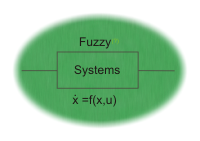Fuzzy systems

Most nonlinear systems contain nonlinearities that are bounded in a bounded region of the state space. Based on this fact, “fuzzy” rules, originally used as smooth interpolators between several behaviours acquired a new meaning and modern fuzzy control, together with LPV control arose in the late 90’s as a successful approach to control nonlinear systems. Takagi-Sugeno (TS) fuzzy models can be regarded as a blending of linear models via non-linear functions. Stability and observer or controller design conditions for these models are usually developed via Lyapunov's direct method.
For the sake of simplicity, classically a quadratic Lyapunov function has been used. Lately, nonquadratic Lyapunov functions gained more interest, with significant results mainly in the discrete-time case, while in the continuous-time their use led to the development of local results.
This research direction focuses on the development of methods for TS models and their practical application in mechanical systems. Specifically, we investigate analysis and design for systems that have a switching nature or that can be described using descriptor models.
Our open and ongoing projects in this area are listed below, together with a selection of completed projects where relevant.
